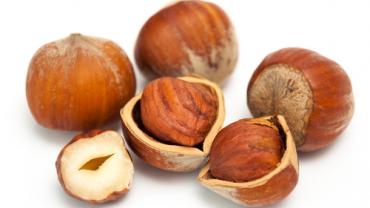
Considering how delicious and versatile nuts are, it’s a good thing science has exonerated dietary fat and we no longer need to avoid every last molecule. Now that nuts and seeds—packed with healthy fats, fiber, vitamins and minerals—have been welcomed back into nutritious diets, let’s take a look at hazelnuts.
Hazelnuts? Yes. For people following a strict Paleo diet, almonds hog an inordinate amount spotlight. And owing to the restriction on legumes, peanuts and cashews are out, so almonds figure prominently, whether eaten as is, or as almond butter with fruit, or ground up almond meal in an endless variety of grain-free cookies, cakes and other baked goods. And people who eat low carb or ketogenic diets might make macadamia nuts a regular staple in their snacking. (Dr. Atkins called macadamia nuts a low carb dieter’s best friend!) And of course, walnuts are a great source of healthy fats, too. But what about hazelnuts?
Hazelnuts, also called filberts, consist primarily of monounsaturated fat (the same one that predominates in olive oil), with tiny amounts of saturated and polyunsaturated fats. One ounce provides about 13 grams of monounsaturated fat, with just 1.3 grams saturated and 2.2 grams of polyunsaturated. The omega-6 to omega-3 ratio is a whopping 87, but with the total amount of polyunsaturated fat at just over a scant 2 grams, this is a non-issue unless someone is getting the vast majority of their caloric intake from hazelnuts. (Anyone who can afford to do that should share their investing tips!)
These delicious orbs are high in thiamin, magnesium, copper and manganese, and provide small amounts of folate, iron and B6. They’re also a good source of vitamin E, which isn’t easy to come by in the modern food supply. And like other nuts and seeds, hazelnuts are at home in many different dietary approaches, including Paleo, ketogenic, low carb, vegetarian and vegan.
What else do hazelnuts have going for them? Like other nuts, they seem to be beneficial for cardiovascular health. In a small study of adults with high cholesterol, four weeks of a “hazelnut-enriched diet” improved the function of blood vessels (called “endothelial function”), reduced triglycerides, total cholesterol, and reduced CRP (a marker of inflammation), and also reduced oxidized LDL. (Research suggests it’s not LDL, per se, that is harmful for cardiovascular health, but rather, oxidized, or damaged LDL particles.) In the interest of full disclosure, the hazelnut-rich diet used in this study had hazelnuts accounting for 18-20% of the subjects’ total calories, which is not exactly something people would do in the real world. That said, some folks might be inclined to swap out a high-carbohydrate food or a source of less wholesome fats in favor of a handful of hazelnuts.
Several other studies support these findings. Men with high cholesterol who ate 40g of hazelnuts per day had a nearly 32% decrease in triglycerides and a 12% increase in HDL (“good cholesterol”). Hazelnut consumption seems to be good even for those with normal cholesterol levels. Healthy subjects who consumed 1 gram of hazelnuts per kilogram of their body weight daily for four weeks had decreases in total cholesterol, LDL and oxidized LDL, along with an increase in the ratio of “large, fluffy” LDL particles to “small, dense” particles. Larger LDL particles are believed to be less harmful for cardiovascular health than the smaller ones.
So how to incorporate more hazelnuts into your diet? It’s perfectly fine to snack on raw or toasted hazelnuts right out of the bag, but for something a little more interesting, how about salads? Hazelnuts could easily be substituted for cashews in this watermelon and fig salad, and they’re a crunchy, flavorful addition to this colorful and savory endive, radicchio and apple salad with porkitos and hazelnuts.
Hazelnuts can be used in savory dishes, but they’re probably best known for desserts, especially in Italy. For grain-free options, try these cookies made with a combination of hazelnut and almond flours, or this low carb, grain-free chocolate hazelnut mousse cake. Thank goodness for creative food bloggers! And if you’re thinking a nice cup of coffee would be the perfect thing to go with these but you miss hazelnut flavored coffee creamer (typically loaded with corn syrup and soybean oil), there’s even a Paleo-friendly homemade version with just one tablespoon of optional honey or maple syrup.
Now, no article about hazelnuts would be complete without mentioning chocolate hazelnut spread, beloved by children and adults alike all over the world. No Parisian crepe cart would be caught without it and breakfast and brunch menus may offer it over pancakes for something truly decadent. But what’s a health-conscious chocolate lover to do? Surely they can’t be expected to forgo this irresistible indulgence forever. Good news! There are low-carb and Paleo-friendly recipes for homemade chocolate hazelnut spread, such as this one from Civilized Caveman Cooking, which calls for just 2 tablespoons of maple syrup for the whole recipes (8 servings), or this one made with 2 tablespoons of coconut palm sugar.
And here’s some quick trivia, in case you’re ever on a game show: Turkey accounts for over 60% of world hazelnut production, with Italy, the U.S., Azerbaijan and Georgia (the nation) making up the majority of the remainder. In the U.S., 99% of hazelnuts are grown in Oregon. (Maybe it’s not a coincidence that Oregon is also famous for coffee roasting.)
Sources